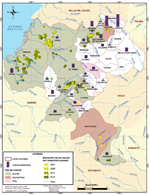Gold fever in times of “peace” - dimensions and implications of the gold advancement in Cauca (Colombia) after the Havana Peace Agreement (Abstract)
DOI:
https://doi.org/10.15381/espiral.v1i1.15844Keywords:
Illegal mining; Human rights defenders; Gold mining; Post conflict; conflict over natural resources.Abstract
The signing of peace agreement in Colombia between the FARC (Revolutionary Armed Forces of
Colombia) and the Colombian government, ended the armed conflict that lasted for more than
50 years. After the signing the most urgent challenges are: the control of the territory left by the
disbandment of the FARC and the management of the wealth of natural resources in the respective
areas. The Cauca department is situated in the country’s southwest and has been one of the most
affected by the past violence and is considered to be amongst the most complicated regions to
implement peace. Reasons being the high level of inequality, the presence of several armed groups,
multiethnicity and its wealth in natural resources, especially gold. Gold has become subject of dispute
and conflict in recent years. Both large-scale mining and artisanal, informal, illegal and criminal mining
have fueled conflict by its accelerated spreading due to the risen goldprice. And, while the national
government seeks to promote development through international investment, locals are many times
opposed to any kind of mining activities. The Principle objective of the article is to investigate on the
dimensions of legal and illegal gold mining in the Cauca after the signing of the peace contract and
quantify economical, ecological and social dimensions of illegal mining. Among them we emphasize
the spatial relationships between illegal mining and murders of human rights defenders. Although we
do not find a direct relationship between illegal mining and human rights violation in all muncipialities,
we show that illegal and legal mining is a threat to peace.

Downloads
Published
Issue
Section
License
Copyright (c) 2019 Dorothea Hamilton, Mary Cusi, Alison Peralta, Anamaría Ruíz

This work is licensed under a Creative Commons Attribution-NonCommercial-ShareAlike 4.0 International License.
LOS AUTORES RETIENEN SUS DERECHOS:
a. Los autores retienen sus derechos de marca y patente, y también sobre cualquier proceso o procedimiento descrito en el artículo.
b. Los autores retienen el derecho de compartir, copiar, distribuir, ejecutar y comunicar públicamente el artículo publicado en la revista Espiral (por ejemplo, colocarlo en un repositorio institucional o publicarlo en un libro), con un reconocimiento de su publicación inicial en la revista Espiral.
c. Los autores retienen el derecho a hacer una posterior publicación de su trabajo, de utilizar el artículo o cualquier parte de aquel (por ejemplo: una compilación de sus trabajos, notas para conferencias, tesis, o para un libro), siempre que indiquen la fuente de publicación (autores del trabajo, revista, volumen, número y fecha).





